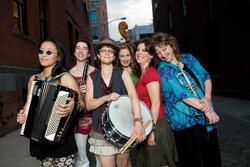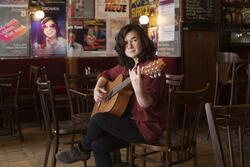7 Questions For Folk Singer Sarah Larsson
JWA talks to Sarah Larsson, a Minneapolis-based folklorist, vocalist, and percussionist.
JWA: You recently released the album Immigrantke (named after the Yiddish word for a female immigrant) with your folk group Red Thread. Can you tell us about the Jewish women’s stories that inspired this album?
Sarah Larsson: My work creating this album grew out of embracing how familiar so many immigration stories are, across many different moments in time and different lineages. My own Jewish great-grandparents immigrated to the US and Canada from what were the Russian and Austro-Hungarian empires in the same decade as my Swedish great-grandfather emigrated from rural Sweden, and they all exchanged correspondence with relatives who stayed behind. On top of those family stories, there are so many folk songs whose lyrics are deeply evocative of love across distance. I combined many of these story-songs with a few of my own to string together a narrative of an imagined immigrant, from the dreamy lost past, into the act of choosing to leave, into the longing for those one is no longer physically near. I hoped that the middle of the album, with some of the soundscapes and wordless melodies, could evoke the in-betweenness of the journey, whether that’s the actual journey across the sea or the journeys our memories take, carrying us back and forth.
JWA: In addition to Red Thread, you’ve also performed in two other all-women groups: the Jewish duo Nanilo and The Nightingale Trio, dedicated to Eastern European and Balkan folk music. What is powerful to you about singing with other women?
SL: I started singing folkloric and traditional music as an undergraduate in the Yale Slavic Chorus, which was an all-women’s ensemble, founded the same year that Yale first admitted women into the school as undergraduates [in 1969]. That group had a long history of being a safe home both for these musical traditions and for the experiences that women and people marginalized by gender experienced at Yale and in the wider world. Many of my fellow alumnae have told stories about how impactful that space was in the 1970s for finding a space to share experience and express one’s own story. That’s certainly an element baked into the music as well—the texts of songs express people’s real lived experience, and when we’re talking about the experience of women, often the songs contain a significant archive of women’s feelings, dreams, and strivings, in ways that otherwise we might lack access to those stories. I also—dang, I just love singing with people whose vocal ranges are similar to mine. There’s nothing better than creating harmonies and feeling voices resonating so closely together.
JWA: While you’ve performed around the world, you organize many classes, concerts, and community events in your home base of Minneapolis. What’s the Jewish music scene there like?
SL: Minneapolis is budding into a new season of Jewish cultural life. In the 1990s and 2000s, there were several great bands in town, as well as a lot of dance and theater performance; however, when I was a young person in Minnesota, as well as when I first moved back in 2012, I didn’t know where to go for Jewish cultural expression that wasn’t a synagogue. I think that as a legacy of American Indian and Black movements for cultural sovereignty that have blossomed in the midwest in the 2010s, and since Jamar Clark’s murder in Minneapolis in particular, many young Jewish folks have sought to stake out what our cultural life looks like, in relation to our support for racial justice and equity movements. So the cultural scene that has grown out of that is very oriented towards solidarity and allyship with communities of color and indigenous communities; we portray our Jewish cultural life in relation to our history as immigrants, and in relation to our elder folks’ long-term advocacy for integrated and just community. We’re also a very queer and queer-friendly art scene; between the organizers, the lefties, and the queer folks and allies, that all adds up to a lot of cultural self-expression, a lot of integration with nature, and a lot a lot of dancing.
JWA: Since the pandemic, you’ve been studying Yiddish language, and you put Yiddish women’s poetry to music for a project for the Cedar Commissions. How has learning Yiddish influenced your career?
SL: Learning Yiddish advanced me in a direction I was already pointed: namely, digging into my own roots, culture, and music. I had previously spent many years advocating for several neighbor communities’ cultural initiatives, at the Somali Museum of Minnesota and African Development Center, as well as learning about folk music from a cultural perspective in the Balkans. I received a super clear message from my teachers and people I admired: Culture is crucial. As a consequence, I knew that a next step was digging into my own roots; however, I didn’t have family contexts in which to learn. Now that I’ve immersed in Yiddishland, I feel like I’m increasingly able to create art that really expresses my own identity and experience, and I’m able to feel like what I’m doing is actually my own.
JWA: You also perform songs in Ladino. What can you tell us about this music and what it illuminates about Sephardi culture?
SL: I primarily study music from the repertoire of Flory Jagoda, so Jewish music from Bosnia as well as elsewhere in the Balkans. My “in” towards this music is because I came to folk music originally from the Balkan music scene, and so I was looking for connection between my own Eastern/Southeastern European identity, which is Jewish, with my existing deep knowledge of Balkan-rooted vocal music and percussion. In addition to Nona Flory’s repertoire, I have been influenced by the work of Nikolai Kaufmann, an important Jewish ethnomusicologist from Bulgaria (his daughter Maria Kaufmann runs a choir based in Sofia), as well as other Jewish musicians actively working in the Balkans, including the Baruch Brothers Choir led by Stefan Zekic, the Bulgar Klezmer Band, Shira Utfila in Belgrade, and Lika Eshkenazi in Sofia. I’ve also learned with David Harris, of the ensemble Voices of Sepharad, based here in Minneapolis. I studied and lived in western Bosnia, where my mentor, Vahidin Omanovic, is a community organizer and culture worker who emphasizes the deep cultural connections between Jewish and Muslim residents of Bosnia, especially in towns and urban areas. Together, Vahidin and I have sung sevdalinke—the “standards” in Bosnian vocal repertoire—many of which have different versions and melodic corollaries in both Jewish and Muslim Bosnian lineage; different communities sing the same tunes and map them onto their own lived experience. This teaches me about the deep interconnection that has existed historically and persists between many of these communities in many places.
JWA: What has learning from heritage singers like Flory Jagoda taught you about singing Jewish language folk songs?
SL: As a learner, it's irreplaceable for me to be able to be in the room with these teachers and engage with the physicality of their singing, letting myself mime and mirror what I see. Beyond that, I’m in it for the stories. There are multiple layers: The stories contained in the lyrics of the songs, the stories of the singers and contexts that these teachers themselves learned from, and then these singers’ own amazing stories of travel, learning, gigs, and community. Actually, one thing that comes up again and again from the teachers I appreciate the most is that this music takes place in community: Flory hosted Sunday afternoon music parties for years and years that brought together musicians and community members to enjoy each other’s company and be immersed in Bosnian Sephardi culture; Beyle Schaechter Gottesman hosted Friday night Zingerayen (singing parties). I hear over and over again that one of the best things is having these songs take place in community.
JWA: In addition to engaging with the Jewish cultural tradition, you’ve performed and studied other folk music traditions, and worked at the Somali Museum of Minnesota. How has this enhanced your understanding of Jewish folk music?
SL: I see everything about this music and engaging in Yiddish culture today as being intertwined with an immigration history. My Somali colleagues in Minnesota are engaged in an active debate about how and to what extent to carry on Somali language and art among the young generations in the US. Our ancestors carried out that same conversation in previous generations. In that vein, it’s fascinating to engage across both cultural contexts—it’s like existing simultaneously in two different points in the timeline. I think I’ve gained a deep understanding that culture really is the tool we need, in order to be healthy and whole versions of ourselves, and therefore to be better neighbors and stewards to other people and to the Earth.







